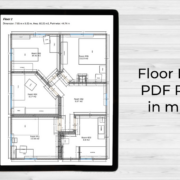Metaroom and DIALux Enhance Efficiency in 3D Modelling for Lighting Design

Metaroom by Amrax, a spatial 3D data capture company, has announced a partnership with the world’s largest lighting design software provider DIALux. The tie-up will enable users to send 3D scan data from Amrax’s Metaroom solution directly to DIALux’s planning software. This new feature will be available from mid-September with the release of DIALux evo 13. This allows the fast creation of precise and detailed light plans for each room.
Scans* can be made in a matter of minutes on any Apple Pro device with a LiDAR sensor and then instantly imported into DIALux. At this point, users can experiment with scores of different factors to find the most cost-effective, aesthetically pleasing, functional and sustainable lighting solution for their space. The partnership between Metaroom and DIALux aims to streamline the spatial design process for professional designers and consequently help to power innovation, sustainable design, and lower costs.
The Metaroom app is an advanced 3D scanning app, driven by the power of AI, LiDAR (Light Detection and Ranging), and SLAM (Simultaneous Localisation and Mapping) technologies. The tool enables professionals in spatial planning industries to envision and redefine spaces. The Metaroom solution is a workflow consisting of the Metaroom app for capture and Metaroom Studio for optimisation before export. Through the Metaroom app users can scan rooms using an iPhone Pro or iPad Pro*. These scans are then uploaded to the cloud, generating true-to-scale 3D models within seconds. Users can then use the web application, Metaroom Studio, to enrich these 3D models with additional information before exporting, ensuring project-specific customisation and precision.
DIALux is the global standard in lighting design software, utilised by over 750,000 active users to design, calculate, and visualise lighting for both indoor and outdoor areas. Featuring real luminaires from over 412 DIALux members, users can create unique atmospheres and generate comprehensive project documentation. Available in 26 languages, DIALux supports a worldwide network of lighting professionals and adheres to the open BIM approach. The integration with Metaroom is also based on open BIM and IFC standards.
DIAL always prioritises the needs of lighting designers in its feature development, aiming to streamline their workflows and simplify their tasks. By using Metaroom, lighting designers can save significant time when designing and placing luminaires. Projects can be conveniently downloaded from Metaroom Studio and imported into DIALux. The planning results can then be exported as an IFC model for the Open BIM process or other programs, significantly reducing the workload.
Martin Huber, CEO of Amrax, said: “Advances in 3D modelling, software and AI are combining to democratise design. Lighting designers and electrical planners now have access to powerful tools that significantly enhance efficiency, enabling them to serve more customers in less time. This is going to lead to a revolution in how buildings are designed and how we all interact with our built environment.
“Partnerships between cutting-edge solutions like Metaroom and DIALux are key to powering this change. By creating an extensive ecosystem of lighting design solutions, we will significantly improve accessibility, reduce costs and bring spatial design to the mainstream.”

Dieter Polle, CEO at DIALux, said: “Simply scan the room with your smartphone and start planning right away. Wouldn’t that be fantastic? By integrating Metaroom into DIALux, this is now possible. The time-consuming task of constructing the geometry before starting the actual lighting design is eliminated. Martin’s team and their solution have convinced us. The integration follows our Open BIM strategy technologically. With this integration, we’ve made life a bit easier for lighting designers.”
Over 11.000 Metaroom users, including key players in the lighting, wireless planning and AEC industries, have registered through the Metaroom app and joined the Amrax B2B ecosystem dedicated to spatial design and 3D modelling.
*Metaroom app’s scanning functionality is currently compatible with all LIDAR-enabled Apple devices (starting from iPhone 12 Pro and iPad Pro 2020 generation devices). However, you can view or download shared 3D models directly in any web browser through Metaroom Studio. The digital twin is created with the Metaroom app within minutes by using RGB and depth sensors from an iPhone or iPad Pro together with deep-learning neural networks. The accuracy of LiDAR sensors of the iPhone 14 Pro model is at 0.5-1 percent. The recognition range is approximately 5 metres.





